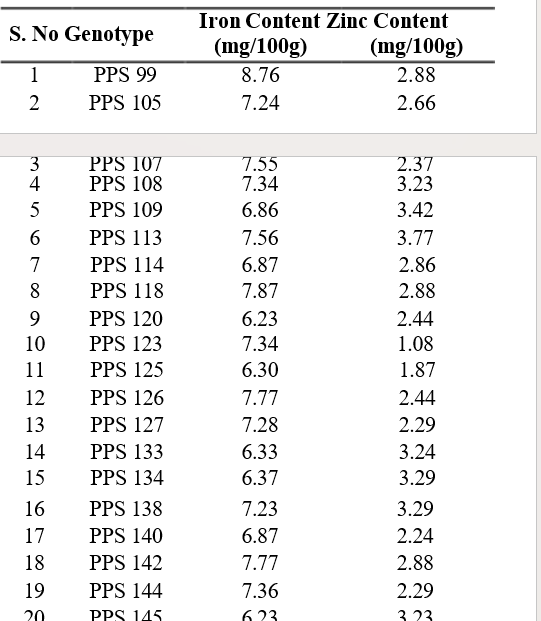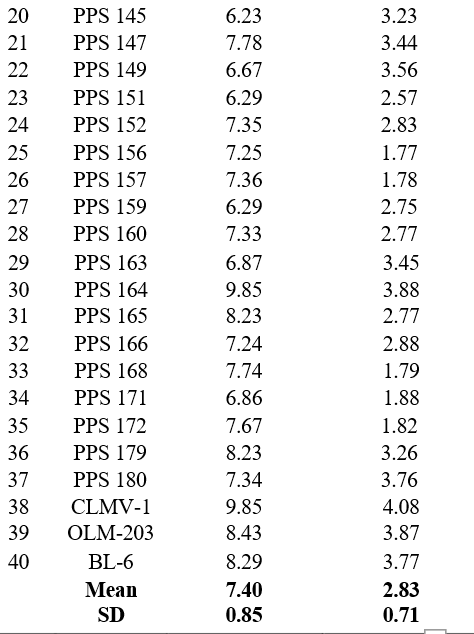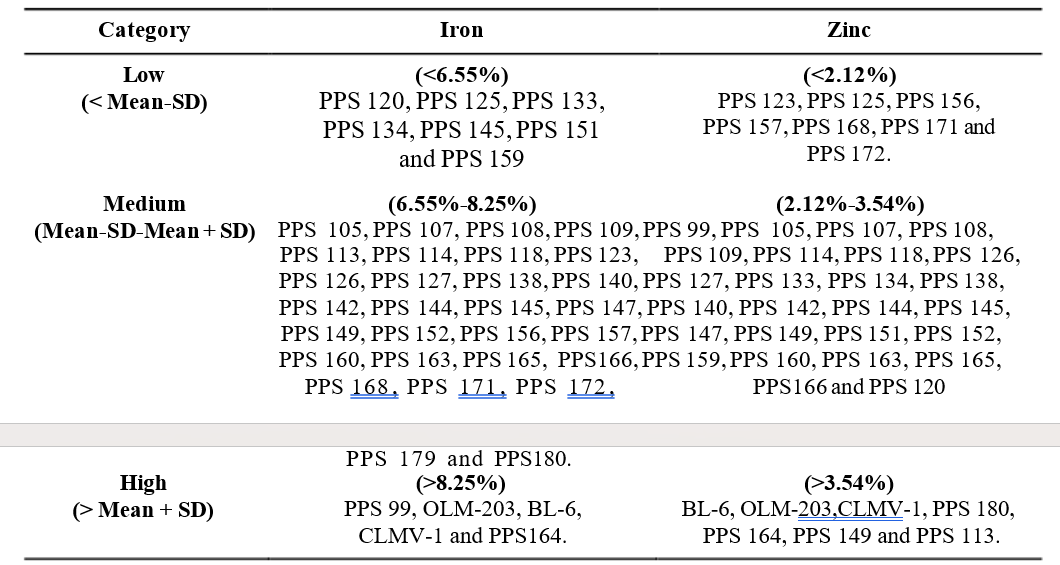Characterization of Grain Iron and Zinc Content in Little Millet Genotypes
0 Views
U. MADHURI*, L. MADHAVI LATHA, P. SHANTHI, SK. NAFEEZ UMAR AND M. REDDI SEKHAR
Department of Genetics and Plant Breeding, S.V. Agricultural College, ANGRAU, Tirupati-517 502.
ABSTRACT
Micronutrient deficiency is a common cause of most of the human diseases. Little millet is an important climate-resilient crop and a rich source of micronutrients, particularly iron and zinc, thus can be helpful to combat iron and zinc malnutrition. Little millet has many health-promoting factors. Identifying and selecting nutrient-rich genotypes within populations is vital for improving the crop’s nutritional value. This process involves evaluating and screening various genotypes for their nutrient content, such as protein quality and mineral composition. In this field experiment, 40 genotypes were evaluated in 3 replications in randomized block design. Maximum iron content was observed for the genotype, CLMV-1 (9.85mg) and PPS 164 (9.85mg) whereas the minimum was observed in PPS145 (6.23mg) with general mean of 7.23mg. The genotypes PPS 99 (8.76mg), PPS 165 (8.23mg), PPS 179 (8.21mg), PPS 118 (7.87mg), PPS 147 (7.78mg) and PPS 126 (7.77mg), recorded significantly higher iron content per 100g of grain. Maximum zinc content was observed for the genotype CLMV-1 (4.08mg) whereas the minimum was observed in PPS156 (1.87mg) with general mean of 2.84mg. The genotypes PPS 164 (3.88 mg), PPS 180 (3.78mg), PPS 113 (3.77mg), PPS 149 (3.56mg), PPS 163 (3.45mg), PPS 147(3.44mg), PPS 109 (3.42mg), PPS 179 (3.26mg) recorded significantly higher zinc content per 100g of grain.
KEYWORDS: Little millet, micronutrients, iron content, zinc content and nutrient rich genotypes.
INTRODUCTION
Iron (Fe) and zinc (Zn) are the most essential micronutrients for human growth and development, especially for infants. Micronutrient malnutrition has been identified as one of the most severe human health- related problems around the world. Iron deficiency is the most noticeable of these having 9th rank, whereas zinc deficiency is at 11th rank among the top twenty risk factors, which contribute to global disease burden. Although there are many adequate sources for these nutrients, still insufficiency is an issue mainly in poor. So, it is important to find the low-cost cereals having high iron and zinc content along with other essential nutrients. Millets may be a viable answer to this issue.
Little millet (Panicum sumatrense Roth ex Roem. & Schult.) is one of the most important small millet crops and is popularly known as sama, samo, vari or kutki belongs to the Poaceae family (Ganapathy et al. 2016). It is quick-growing, short-duration and hardy crop that can withstand drought and waterlogging to a certain degree. It was domesticated in the Eastern Ghats of India occupying a major portion of the diet amongst the tribal people and spread to Sri Lanka, Nepal, and Myanmar. In India, its cultivation is mostly confined to the tribal belt of Madhya Pradesh, Chattisgarh and Andhra Pradesh (Natesan et al. 2020). Little millet is considered as best nutri-cereal as it is nutritionally rich, as 100 g of seed contains high protein (7.70 g), zinc (3.70 mg), iron (9.30 mg), magnesium (114.00 mg), calcium (17.00 mg), phosphorus (220.00 mg), carbohydrate (76.70 g), fat (4.79 g), calories 329 kcal, minerals (1.50 g), fiber (7.60 g) (Nandini et al. 2016). Little millet grain is a low glycemic index food that is also rich in dietary fiber. Identifying and selecting nutrient-rich genotypes within populations is vital for improving the crop’s nutritional value.
MATERIAL AND METHODS
Forty genotypes of little millet were evaluated in three replications under randomized block design at the Agriculture Research Station, Perumallapalle, Tirupati.
The experiment is conducted to identify the high- yielding genotypes with significant amounts of Fe, and Zn content.
Procedure for extraction of micronutrients
One gram of sample was taken into a 100 ml conical flask and 10 ml of a di-acid mixture of HNO 3 and HClO4 in the ratio of (9:4) was added and kept for overnight digestion. The sample with diacid is kept on a heat hot plate. The contents were then heated at a higher temperature until the production of NO2 fumes ceased. Later the contents were evaporated until 3 to 5 ml digest was obtained but not to dryness. The completion of digestion is confirmed when the liquid becomes colourless. After cooling the flask, 50 ml of double idnitsotilale1d00wamtelrvwolausmaedtrdiecdfltaoskthweitdhigthesetWanhdattmr ansnfenrore:1d filter paper and the volume was made up to 100 ml with double distilled water. Then, the iron and zinc content in the samples was determined with the help of an Atomic Absorption Spectrophotometer (AAS) (Lindsay and Norvell., 1978).
RESULTS AND DISCUSSION
Micronutrient analysis of grain was performed in forty little millet genotypes to determine iron and zinc
concentration. Iron and zinc content of little millet genotypes was presented in Table 1. The elemental
analysis of little millet results depicted significant variation in iron concentrations ranging from 6.34
mg/100g to 9.85 mg/100g whereas zinc content ranging from 1.87 mg to 4.08 mg/100g. Maximum iron content was observed for the genotype CLMV-1 (9.85mg) and PPS 164 (9.85mg) whereas the minimum was observed in PPS 145 (6.23mg) with general mean of 7.23mg. The genotypes PPS 99 (8.76mg), PPS 165 (8.23mg), PPS 179 (8.21mg), PPS 118 (7.87mg), PPS 147 (7.78mg) and PPS 126 (7.77mg), recorded significantly higher iron content per 100g of grain. Genotypes PPS145 (6.23mg), PPS 120 (6.24mg) PPS 151 (6.29 mg) and PPS 133 (6.33 mg) recorded lower iron content per 100g of grain. Maximum zinc content was observed for the genotype CLMV-1 (4.08mg) whereas the minimum was observed
in PPS 156 (1.87mg) with general mean of 2.84mg. The genotypes PPS 164 (3.88 mg), PPS 180 (3.78mg), PPS 113 (3.77mg), PPS 149 (3.56mg), PPS 163 (3.45mg), PPS 147(3.44mg), PPS 109 (3.42mg), PPS179 (3.26mg) recorded significantly higher zinc content per 100g of grain.
The genotypes were grouped into three categories, high, medium and low based on their iron and zinc content using mean and standard deviation values. Classification of little millet genotypes based on iron and zinc content was presented in Table 2.
The genotypes were grouped into 3 classes i.e. low, medium and high based on the grain iron and zinc
content of forty genotypes of little millet. Five genotypes
Table 1. Iron and zinc content of little millet genotypes (in mg/100g)


Table 2. Classification of little millet genotypes based on iron and zinc content

fall under high iron content (>8.25mg/100g), twenty- eight fall under medium (6.55-8.25mg/100g), and seven fall under the low category (<6.55mg/100g). Seven genotypes fall under high zinc content (>3.54mg/100g), twenty-six fall under medium (2.12-3.54mg/100g) and seven fall under the low category (<2.12mg/100g). This variation of iron and zinc content in little millet grains is nearly consistent with results obtained by Manimozhi et al. 2015, Kundagol et al. 2015, Singane et al. 2018, Kaushal et al. 2023 and Panda et al. 2024.
The study revealed significant variation in iron and zinc content among different little millet genotypes. Genotypes such as CLMV-1 and PPS 164 were rich in both iron and zinc, making them excellent candidates for breeding programs aimed at enhancing the nutritional value of millet. In contrast, genotypes like PPS 145 (low in iron) and PPS 156 (low in zinc) could benefit from genetic selection or agronomic improvements. This analysis provides valuable insights for selecting genotypes with optimal micronutrient content, which is crucial for combating nutritional deficiencies in populations that depend on little millet as a staple food
LITERATURE CITED
Ganapathy, K.N. 2017. Genetic improvement in little millet. Millets and Sorghum: Biology and Genetic Improvement. 170-183.
Kaushal, L., Thakur, R., Anjani, K and S.K. Singh. 2023.
Biochemical characterization of grain iron and zinc content in little millet (Panicum sumatrance Roth Ex Roem and Schult.) genotypes. Electronic Journal of Plant Breeding. 10(2): 566- 569.
Kundgol, N.G., Kasturiba B., Math, K.K., Kamatar, M.Y and Usha, M. 2013. Impact of decortication on chemical composition, antioxidant content and antioxidant activity of little millet landraces. International Journal of Engineering Research and Technology. 2: 1705-1720.
Lindsay, W.L and Norvell, W.A. 1978. Development of a DTPA soil test for zinc, iron, manganese and copper. Soil Science Society of American Journal. 42: 421-428
Manimozhi S.V., Nirmalakumari, A and Senthil, N. 2015. Genetic diversity for zinc, calcium and iron content of selected little millet (Panicum sumatrance Roth Ex Roem and Schult.) genotypes. Journal of Nutrition and Food Sciences 5(417): 2.
Nandini, C., Sujata, B., Krishnappa, M and Aruna, Panda, Y.R. 2016. Genetic variability, heritability, genetic advance and character association studies in F3 generation of cross JK-8 × Peddasame (purple late) in little millet (Panicum sumatrense Roth Ex Roem and Schult.). Asian Journal of Bio Science. 11(2): 244-249.
Natesan, S., Venugopalan, G., Selvamani, S.B and Angamuthu ,N .2020 .Characterizatio no flittl emillet (Panicum sumatrense Roth Ex Roem and Schult.) varieties using morphological descriptors. Journal of Phytology. 12: 29-34.
D., Muni, P., Panda, A., Lenka, K.C and Parida, P.K. 2024. Nutritional and nutraceutical richness of neglected little millet (Panicum sumatrense Roth Ex Roem and Schult.) genotypes from Eastern Ghats of India: implications for breeding and food value. Planta. 259(2): 37.
Singane, S., Gomashe, S., Ganapathy, K.N and Patil, J.V. 2018. Genetic variability and association analysis for grain yield and nutritional quality in little millet. Journal of Bioresource. 9(6): 596-600.
- Effect of Foliar Application of Nano Urea on Growth and Yield of Fodder Maize
- Studies on Effect of Antibiotic on Biological Parameters Of Diamondback Moth, Plutella Xylostella (Linnaeus)
- Estimation of Genetic Variability for Yield and Yield Attributing Traits in Sesame (Sesamum Indicum L.)
- An Economic Analysis of Community Hiring Centres (Chcs) in Chittoor District of Andhra Pradesh
- Development and Validation of Gc-Ecd Method for Determination of Profenophos in Pigeonpea
- Assessment of Soil Major Nutrients in Scarce Rainfall Zone of Andhra Pradesh

